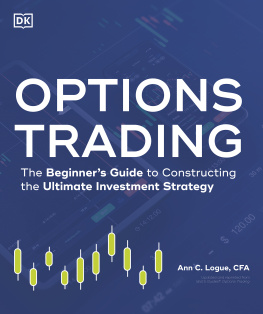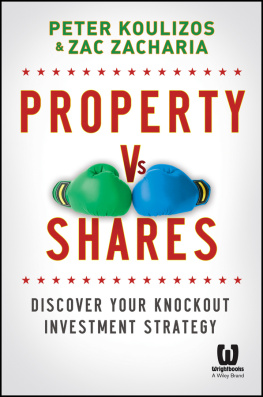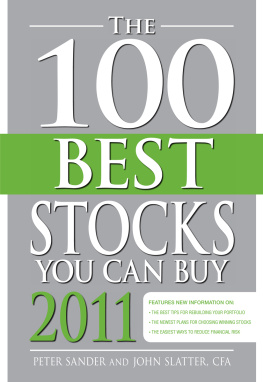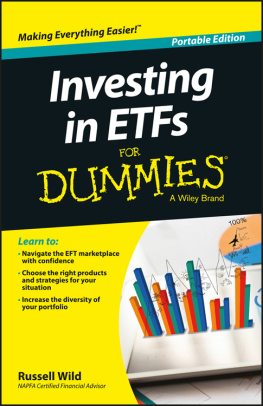Peter Stanyer - Guide to Investment Strategy
Here you can read online Peter Stanyer - Guide to Investment Strategy full text of the book (entire story) in english for free. Download pdf and epub, get meaning, cover and reviews about this ebook. year: 2018, publisher: PublicAffairs, genre: Romance novel. Description of the work, (preface) as well as reviews are available. Best literature library LitArk.com created for fans of good reading and offers a wide selection of genres:
Romance novel
Science fiction
Adventure
Detective
Science
History
Home and family
Prose
Art
Politics
Computer
Non-fiction
Religion
Business
Children
Humor
Choose a favorite category and find really read worthwhile books. Enjoy immersion in the world of imagination, feel the emotions of the characters or learn something new for yourself, make an fascinating discovery.

- Book:Guide to Investment Strategy
- Author:
- Publisher:PublicAffairs
- Genre:
- Year:2018
- Rating:3 / 5
- Favourites:Add to favourites
- Your mark:
- 60
- 1
- 2
- 3
- 4
- 5
Guide to Investment Strategy: summary, description and annotation
We offer to read an annotation, description, summary or preface (depends on what the author of the book "Guide to Investment Strategy" wrote himself). If you haven't found the necessary information about the book — write in the comments, we will try to find it.
Guide to Investment Strategy — read online for free the complete book (whole text) full work
Below is the text of the book, divided by pages. System saving the place of the last page read, allows you to conveniently read the book "Guide to Investment Strategy" online for free, without having to search again every time where you left off. Put a bookmark, and you can go to the page where you finished reading at any time.
Font size:
Interval:
Bookmark:
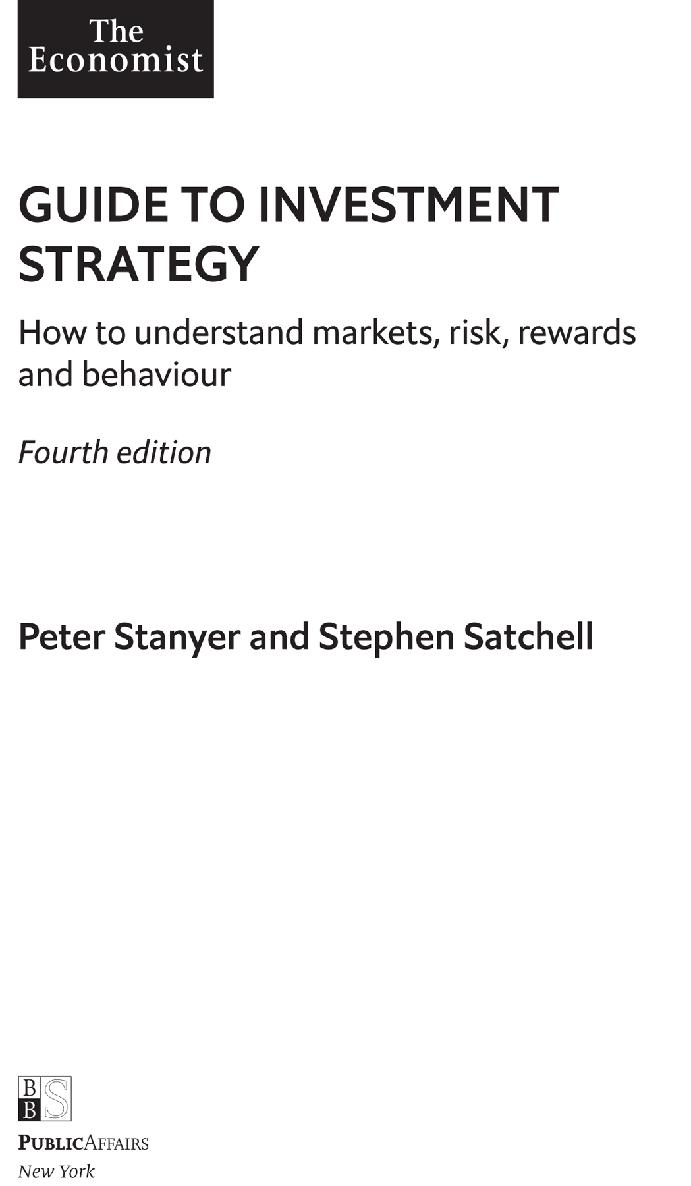
Copyright 2018 by the Economist Newspaper Ltd, 2006, 2010, 2014, 2018
Text Copyright Peter Stanyer, 2006, 2010, 2014; Peter Stanyer and Stephen Satchell, 2018
Hachette Book Group supports the right to free expression and the value of copyright. The purpose of copyright is to encourage writers and artists to produce the creative works that enrich our culture.
The scanning, uploading, and distribution of this book without permission is a theft of the authors intellectual property. If you would like permission to use material from the book (other than for review purposes), please contact permissions@hbgusa.com. Thank you for your support of the authors rights.
PublicAffairs
Hachette Book Group
1290 Avenue of the Americas, New York, NY 10104
www.publicaffairsbooks.com
@Public_Affairs
The Economist in Association with Profile Books Ltd. and PublicAffairs
Originally published in 2018 by Profile Books Ltd. in Great Britain. First US Edition: May 2018
Published by PublicAffairs, an imprint of Perseus Books, LLC, a subsidiary of Hachette Book Group, Inc. The PublicAffairs name and logo is a trademark of the Hachette Book Group.
The greatest care has been taken in compiling this book. However, no responsibility can be accepted by the publishers or compilers for the accuracy of the information presented.
Where opinion is expressed it is that of the author and does not necessarily coincide with the editorial views of The Economist Newspaper.
While every effort has been made to contact copyright-holders of material produced or cited in this book, in the case of those it has not been possible to contact successfully, the author and publishers will be glad to make amendments in further editions.
The publisher is not responsible for websites (or their content) that are not owned by the publisher.
Library of Congress Cataloging-in-Publication Data has been applied for.
ISBNs: 978-1-61039-979-1 (paperback), 978-1-61039-987-6 (ebook)
E3-20180323-JV-NF
WE OWE A DEBT OF GRATITUDE to many individuals who helped with this book. First and foremost to our wives, Alex and Ana, for their continued support and patience through this editions labour.
Very notably, Grant Wilder provided invaluable research assistance with this new edition.
Generous and insightful contributions on particular issues or chapters were provided by Elroy Dimson, Stephen Collins, Harold Evensky, Hugh Ferry, Masood Javaid, Tim Lund, Moira OShaughnessy, Steve Piercy, Mark Ralphs, Adrian Howe, Rory Percival, Jay Tallis and Richard Williams. We are most grateful to each of them, but any mistakes are our own.
We are also indebted to those firms whose data we have used in the numerous tables and charts. Without their support the book could not be published in this form. We would also like to thank Ed Lake at Profile Books for his encouragement, suggestions and support. Our thanks are also due to Penny Williams, who edited the previous editions, and Catherine Garson, who edited this latest editionboth were skilful and patient.
This book aims to help inform the process of seeking and giving professional advice, but it cannot be a substitute for that advice. Nothing should be interpreted as a recommendation to do or not to do anything in particular. It draws on and summarises research and investor perspectives on a wide range of issues, but it is not punctuated with footnotes citing sources for facts or opinions. Although important areas of debate are flagged with references to leading researchers, in other areas ideas which are more commonly expressed are presented but not attributed. Sources which were particularly important for each chapter are listed in Appendix 2.
Please note that the views expressed in this book are our own and may not coincide with the views of the investment funds or other bodies on whose boards or committees we are honoured to serve and advise.
Guide to Analysing Companies
Guide to Cash Management
Guide to Commodities
Guide to Country Risk
Guide to Decision Making
Guide to Emerging Markets
Guide to Financial Management
Guide to Financial Markets
Guide to Intellectual Property
Guide to Management Ideas andGurus
Guide to Managing Growth
Guide to Organisation Design
Guide to Project Management
Guide to Supply Chain Management
Numbers Guide
Style Guide
Economics: an A-Z Guide
Negotiation: an A-Z Guide
Pocket World in Figures
Book of Business Quotations
Book of Isms
Book of Obituaries
Brands and Branding
Business Consulting
Business Strategy
Buying Professional Services
The Chief Financial Officer
Economics
The Economist Cover Story
The Fate of the West
Frugal Innovation
Game Query
Go Figure
The Great Disruption
Growing a Business
Managing Talent
Managing Uncertainty
Marketing
Marketing for Growth
Megachangethe world in 2050
Megatechtechnology in 2050
Modern Warfare, Intelligence andDeterrence
Organisation Culture
Successful Strategy Execution
Treasure Palaces
Unhappy Union
Why Deals Fail
The World in Conflict
THE FINANCIAL CRISIS OF 200709 has had enormous consequences, but it has not led to major changes in the investment policies followed by institutional and private investors. One trend that has been accelerated by the crisis, and its aftermath of ultra-low interest rates, is the rapid move in various countries towards complete closure of company-sponsored salary-related pension schemes. Millions are now confronted with the challenge of building up their own pension pot to fund their retirement. Many of these, who, it is reasonable to suppose, have no particular interest in investment markets, need to be conscious of whether their savings are sufficient and on track, and sensibly invested. This new edition is deliberately tilted to address these kinds of concerns of the private investor (see on personal pensions, in particular).
Many of these concerns parallel those facing institutional funds. Since the crisis, earlier investment trends have been extended, rather than new trends emerging. There has been a growing recognition by all types of investors of the importance of globally diversified equity portfolios ().
Twenty-five years ago, both authors would have been confident that investment manager fees would have been under relentless pressure in the decades ahead. Time has so far shown such a prediction to have been only half-right. However, even the most modest investor can now find easy access to reputable low-fee strategies of equity and bond investments that might suit their needs and which are comparable to those discussed in the first part of the book. Norways oil fund (formally known as the Government Pension Fund (Global)), which is reported to be the largest fund in the world, has essentially followed such a strategy, since 1997. Warren Buffet, who has a reputation as one of the most successful professional investors, suggested in 2017 that American investors who are saving for retirement should consistently buy an S&P500 low-cost index fund I think its the thing that makes the most sense practically all of the time.
As very low interest rates have persisted, stockmarkets have seemingly become more expensive. Bond markets automatically translate low interest rates, which are expected to persist, into much higher bond prices and it is widely believed that this helps to explain the buoyancy of prices for a wide range of collectibles, from works of art to classic cars (see ).
Font size:
Interval:
Bookmark:
Similar books «Guide to Investment Strategy»
Look at similar books to Guide to Investment Strategy. We have selected literature similar in name and meaning in the hope of providing readers with more options to find new, interesting, not yet read works.
Discussion, reviews of the book Guide to Investment Strategy and just readers' own opinions. Leave your comments, write what you think about the work, its meaning or the main characters. Specify what exactly you liked and what you didn't like, and why you think so.


